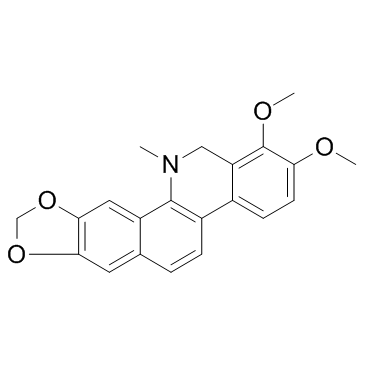Dihydrochelerythrine (12,13-Dihydrochelerythrine) |
| Catalog No.GC33941 |
Dihydrochelerythrine (12,13-Dihydrochelerythrine) is a natural compound isolated from the leaves of Macleaya microcarpa; has antifungal activity.
Products are for research use only. Not for human use. We do not sell to patients.

Cas No.: 6880-91-7
Sample solution is provided at 25 µL, 10mM.
Dihydrochelerythrine is a natural compound isolated from the leaves of Macleaya microcarpa; has antifungal activity.IC50 value:Target: in vitro: Dihydrochelerythrine showed the highest antifungal activity against B. cinerea Pers, with 98.32% mycelial growth inhibition at 50 μg/mL. Dihydrochelerythrine inhibited spore germination in vitro in a concentration-dependent manner [1]. Dihydrochelerythrine appeared to be less cytotoxic since the viability of cells exposed to 20 microM dihydrochelerythrine for 24h was reduced only to 53%. A dose-dependent induction of apoptosis and necrosis by chelerythrine and dihydrochelerythrine was confirmed by annexin V/propidium iodide dual staining flow cytometry [2]. Dihydrochelerythrine (4) exhibited strong activity against methicillin-resistant Staphylococcus aureus SK1 and moderate activity against Escherichia coli TISTR 780 with MIC values of 8 and 16 μg/mL, respectively [3].
[1]. Feng G, et al. Inhibitory activity of dihydrosanguinarine and dihydrochelerythrine against phytopathogenic fungi. Nat Prod Res. 2011 Jul;25(11):1082-9. [2]. Vrba J, et al. Chelerythrine and dihydrochelerythrine induce G1 phase arrest and bimodal cell death in human leukemia HL-60 cells. Toxicol In Vitro. 2008 Jun;22(4):1008-17. [3]. Tantapakul C, et al. Antibacterial compounds from Zanthoxylum rhetsa. Arch Pharm Res. 2012 Jul;35(7):1139-42.
Average Rating: 5 (Based on Reviews and 35 reference(s) in Google Scholar.)
GLPBIO products are for RESEARCH USE ONLY. Please make sure your review or question is research based.
Required fields are marked with *




















